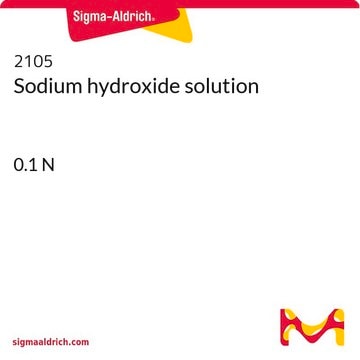13-1730
Hydrochloric acid
0.1 M
Synonym(s):
Hydrogen chloride solution
About This Item
Recommended Products
product name
Hydrochloric acid solution, 0.1 M
vapor pressure
190 mmHg ( 25 °C)
form
liquid
availability
available only in Japan
concentration
0.1 M
1/10 N
bp
100 °C (lit.)
density
1 g/cm3 at 20 °C
SMILES string
Cl
InChI
1S/ClH/h1H
InChI key
VEXZGXHMUGYJMC-UHFFFAOYSA-N
Looking for similar products? Visit Product Comparison Guide
Application
- Research on the Synthesis of Zinc-Ammonium Phosphate Using Galvanic Waste Sludge as a Source of Zinc: This study explores a novel approach using hydrochloric acid solution in the synthesis process aimed at valorizing waste materials. The article demonstrates a chemical strategy that enhances resource recovery, significantly contributing to waste minimization in industrial practices (Morgovan et al., 2024).
- Contactless conductivity sensor employing moist paper as absorbent for in-situ detection of generated carbon dioxide gas: The study integrates hydrochloric acid solutions in the development of a novel, cost-effective contactless conductivity sensor. This sensor uses a simple paper-based system for the in-situ monitoring of gases, providing a significant tool in environmental monitoring and analysis (Nacapricha et al., 2020).
Signal Word
Warning
Hazard Statements
Precautionary Statements
Hazard Classifications
Met. Corr. 1
Storage Class Code
8B - Non-combustible corrosive hazardous materials
WGK
nwg
Flash Point(F)
Not applicable
Flash Point(C)
Not applicable
Certificates of Analysis (COA)
Search for Certificates of Analysis (COA) by entering the products Lot/Batch Number. Lot and Batch Numbers can be found on a product’s label following the words ‘Lot’ or ‘Batch’.
Already Own This Product?
Find documentation for the products that you have recently purchased in the Document Library.
Our team of scientists has experience in all areas of research including Life Science, Material Science, Chemical Synthesis, Chromatography, Analytical and many others.
Contact Technical Service


